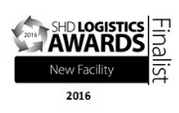Every day, technology is growing to become more intelligent and advanced. Artificial Intelligence, Warehouse Automation, the threat of robots replacing the role of low-skilled human labour, not to mention autonomous vehicles being discussed, in a bid to avoid the potential pitfall, and already noticeable decrease, in the number of human haulage drivers; just some examples of the dramatic changes continuously occurring across the westernised warehousing Industry.
As smart technology continues to develop, it is undeniably shaping the ‘warehouse of the future’.
However, as technology continues to improve, there are assumptions that these improvements will automatically follow-through to bettering the productivity of the environments into which they are introduced.
Take for example AI, which has everyone excited because it has the ability to not only increase efficiencies and service clients at a lower cost, but also promises potential to create a more accurate, and flexible business model that is not only versatile and scalable, but also importantly provides improved forecasting ability, to eliminate previous inaccurate and time-consuming estimations; perfect to implement in the ever-changeable logistics arena.
Associated with increasing the efficiency, and effectiveness of facility processes, Warehouse Automation is also a popular technology of choice amongst many warehouse managers; and by the same token, so is Robotic Process Automation (RPA).
All present similarly positive attributes, including providing warehouse managers with not only more cost effective and efficient operations, but also, with a steady supply of machine labour when facing a potential human labour shortage.
However, adopting these innovative technologies, does not come without responsibility.
Despite the many unrealistic representations of warehouse technology, automatically creating a much improved and hassle-free environment, the warehouse of the future still requires a significant amount of human intervention. “If you automate a process that has errors, all you’ve done is automate the generation of those errors” (W.L.W. Borowiecki).
Take autonomous vehicles for example: the driving force for the operation of fully autonomous vehicles on our roads encompasses key legal, infrastructure, and economic matters which require complete consideration and planning, prior to full implementation, before any kind of driver-less vehicles are authorised to rule our roads.
Key motivators behind, what are now almost mandatory technological improvements to our warehouses, have been instigated by the growth of other extraneous technology, including smart phones, Wi-Fi, and ecommerce.
These have subsequently impacted upon logistics processes, warehouses have seen an increase, thanks to technology, in consumer demand now being the driving force, with some manufacturers adopting not only technology to complete repetitive warehouse processes, but also implementing somewhat unsustainable ‘direct to consumer’ (DTC) strategies, just to keep up with the demand, all in a bid to prevent losing customers to their rivals – in turn, investing in expensive omnichannel initiatives to increase sales, increase market share, and improve customer loyalty.
These revolutionary technologies, whilst poised to make implementation easier, forecasting better, risk management more proactive, and improve usability; it seems presently, that the warehouse of the future, is growing to be a bigger beast than can be presently controlled, and the adoption of modern technologies, although helpful, is not a quick easy fix to an environment, which is realistically responding to ever growing demand every day.
Whilst technology can help us to fulfil an absence of human labour, and essentially drive down overall costs within many companies’ supply chains, there is still a need for the warehouse of the future to ensure that the innovations being developed and introduced into facilities now, not only consider the demands of consumers, and tech advancements of today, but also acknowledge scalability for the future.
Whilst the challenges of digitisation within the Logistics Industry are not insurmountable, they do need to be diligently considered, for reliability, profitability, and realistic scalability; if technology is to be a key indicator for the future of improving logistics processes.
Sharing a synonymous perspective, The Cities Outlook Report 2018 – considers how automation and globalisation will boost job creation; preparing business leaders at both local and national level to act to help prepare for the impact of automation, and ultimately the Warehouse of the Future.
















